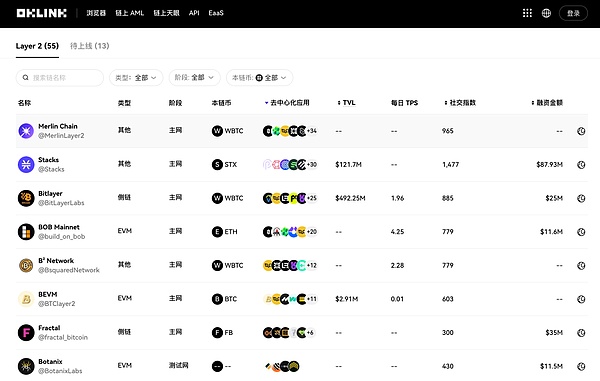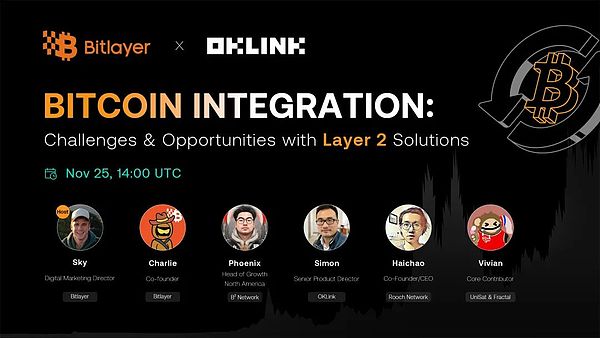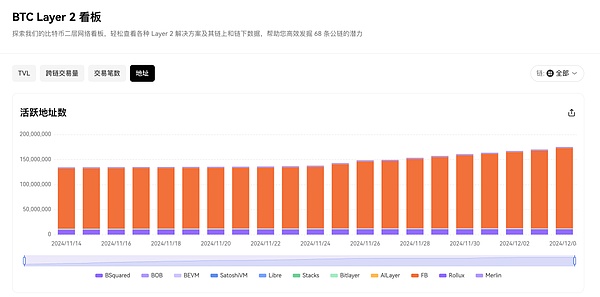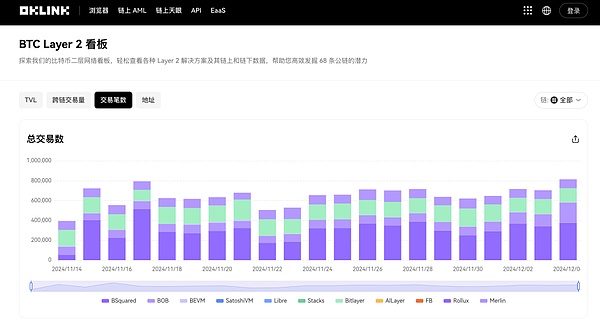Undoubtedly, as a decentralized and secure blockchain network, the core value of Bit in the minds of the public is the value storage of "digital gold". However, this may be just the "tip of the iceberg" of its potential.
The huge liquidity and trust foundation of Bit can serve as the core pillar for many innovative use cases, but the existing infrastructure is obviously not enough to support these visions. Bit needs to break through its architectural constraints, embrace scalability and programmability, in order to play a more important role in Web3.
Infrastructure and Developer Empowerment
Technological breakthroughs are key to the development of the Bit ecosystem. For example, Layer 2 and sidechain solutions can bring efficient and secure scalability to Bit, allowing developers to realize more complex use cases on the Bit network. However, technology alone is not enough, the acceptance of developers and users is also important.
(The image shows the real-time ranking of Layer2 on the OKLink official website)
Currently, many developers still face problems such as lack of tools and incomplete documentation. Users also need deeper understanding of how to benefit from the new ecosystem mechanisms. Only by jointly promoting technology and education can the potential of the Bit ecosystem be truly activated.
Unleashing Value from Storage to Creation
The future Bit ecosystem is not just about "holding", but about creating value as a platform. Through more powerful technical infrastructure and developer support, Bit can become the core platform for tokenization of real assets, cross-chain and high-performance decentralized applications. These innovations will bring a new growth curve to Bit, and also provide more opportunities for global users and developers.
How can data infrastructure drive ecosystem development?
Simon, Product Director of OKLink, said that OKLink is committed to promoting the bridging and integration of the Bit ecosystem. In order to unleash the full potential of Bit, the data infrastructure led by the browser needs to take on the responsibility of promoting the integration and bridging of these new technologies. By building trust-minimized bridging technology, improving the scalability of Bit, and ensuring the secure circulation of assets between Bit and other chains.
For example, the BTC Layer 2 dashboard function of OKLink can provide detailed data charts on TVL, cross-chain transaction volume, transaction count and address dimensions, helping users easily view various Layer 2 solutions and their on-chain and off-chain data, and efficiently explore the potential of 68 public chains.
https://www.oklink.com/en/btc-layer2
How do industry experts view the future of the ecosystem?
Recently, OKLink and its partner Bitlayer jointly hosted a special AMA on "the challenges and possibilities of integrating Bit with other ecosystems through Layer 2 or sidechain solutions". OKLink's partners, leading ecosystem projects B² Network, Fractal and Rooch Network, shared their unique insights based on their practical experience.
What are the key infrastructure needs to support Layer 2 and sidechain solutions, and how to promote their integration with other ecosystems?
Charlie@Bitlayer: Demand exists, but infrastructure is lacking
Although we have various compatible sidechain technologies and virtual machine ecosystems, these sidechains do not provide secure feedback to the Bit main chain, and they are essentially not native Layer 2 networks either. The transaction bridging technology to the sidechain has not truly returned to the Bit main chain, so it cannot achieve the same level of security as the main chain. This creates a trust assumption - you need to socially trust that the validator cluster on the sidechain is secure. If the sidechain encounters extreme problems, users' assets are difficult or even impossible to extract back to the Bit main chain.
There are also economic reasons. In the second quarter of 2024, the overall transaction fees on the Bit network were 80 Bit, while in the third quarter it was only 10 Bit. Obviously, the entire business model of miners is based on the growth of Bit price and market capitalization. The higher the price, the greater the demand for miners, because block rewards exist. But if there are no transaction fees paid on the Bit main chain, such as no one paying fees for Bit transfers, the miners' revenue will gradually decrease, which is detrimental to the entire ecosystem.
This problem is actually the "elephant in the room". The solution is that we need a Layer 2 network that is equivalent to the security of the Bit main chain, and at the same time build programmability around the Layer 2 network.
As more and more new users want to earn returns, this demand is obvious. This is consistent with the basic principles of modern finance: when you have assets, you don't want to sell them, but want to generate returns through methods like collateral loans.
Phoenix@B² Network: Super early, a rising tide lifts all boats
Bit is the project with the highest brand awareness and the easiest for non-crypto users to accept in the entire crypto field. Sometimes we are too focused on the internal perspective and ignore the broader external market - the non-crypto people are actually a much larger potential user group.
I don't think the problem is competing with each other in the same space, but finding more ways to attract new users. But obviously, there are still shortcomings in the infrastructure, so there is an urgent need to expand the solutions.
This is also the reason why we chose to build on Layer 2 of Bit, while striving to retain Bit's core advantages - the most decentralized and secure. We are starting to see more traditional financial institutions gradually entering this field. For example, Coinbase's app has once again become the most downloaded app on the App Store. As the old saying goes, "a rising tide lifts all boats". I am very optimistic about the future and can't wait to see what will happen.
(The image shows the active address count statistics on the OKLink website)
Simon@OKLink: "Sustainable" user experience
Some of Bit's basic infrastructure has indeed played a key role. But there is still a lot to be improved in terms of sustainability and user experience. This is also why some early developers may have been active for a while and then turned to developing tools in other ecosystems that are more user-friendly.
However, with the emergence of Layer 2 and more development tools, we can now see the tools and platforms in the Bit ecosystem becoming more prosperous. I believe that with the drive of these innovative applications and solutions, the user experience will be significantly improved.
In terms of tool development, we collaborate with multiple blockchain networks, and also focus on native Bit development, in order to better serve the evolution of the entire ecosystem and learn from it.
The last point is about community outreach and promotion. We are committed to in-depth interaction with users through various activities, helping them understand the usability and security of Bit, while exploring how to seamlessly connect Bit with other ecosystems.
What are the biggest obstacles for developers and early adopters to enter the Bit ecosystem, and what tools can help them?
Simon@OKLink: Availability of tools and data
The first obstacle is the availability of tools and the lack of best practices. The second key issue is the availability and interoperability of data. Currently, other ecosystems have attracted a large number of users and decentralized application development, while the user base and community support of the Bit ecosystem is relatively limited, which has also constrained the development of the ecosystem. We are working to gradually eliminate these barriers through protocol architecture design and tool development, making the Bit ecosystem more friendly and efficient.
Vivian@Fractal: Clear documentation and use cases
Fractal is built on Bit, and EVM developers may initially question its feasibility, finding Fractal's environment completely different and complex, and this unfamiliarity poses challenges, so we need to provide clear documentation and use cases to help developers understand the protocol and application implementation.
Therefore, we have improved the documentation, created a more developer-friendly environment, opened up APIs and services, and lowered the threshold for teams to enter the Bit ecosystem. In addition, by collaborating with infrastructure providers like OKLink, we are committed to building data tools like browsers that are crucial for developers, hoping to promote collaboration between teams through the "developers helping developers" ecosystem, and jointly build a healthy Bit development environment.
Haichao@Rooch: Easy-to-use and compatible solutions
The obstacle is that everything needs to be built from scratch. Previously, there was no ready-made Move virtual machine solution, so we had to build it from the ground up, generating secure software proofs.
Another aspect is how to connect the Move virtual machine with Bit, thereby realizing the migration of assets and various functions. The Move virtual machine is inherently highly compatible with Bit assets, which allows us to build all the existing functions, including using Bit wallets for locking, operating Bit assets, or running assets in a UTXO-like mode.
Currently, we have successfully enabled developers to develop using Move on the Bit chain. In the future, we will further explore how to leverage Bit network solutions to improve performance and interoperability.
Summary and Outlook: What do you think Bit will be like in 3 months or 2 years?
Within the next three months, many projects will be launched and create great attraction and momentum in the Bit ecosystem;
It is expected that with the continuous growth of users and developers, more institutions will enter the Bit ecosystem, driving its maturity and the development of more application scenarios;
With the development of solutions and technologies, users will be able to enjoy a more seamless cross-platform experience;
(The figure shows the transaction volume statistics on the OKLink official website)
Bit's applications may become more diverse, especially in terms of privacy protection and cross-chain interoperability; some new protocols and applications are also expected to become new highlights in the market.
Overall, with the entry of more large companies and institutions, the future Bit ecosystem is expected to usher in a more mature and diversified development, let's wait and see.
*The content mentioned in this article is a summary of the guest's views, and should not be regarded as specific investment advice.












